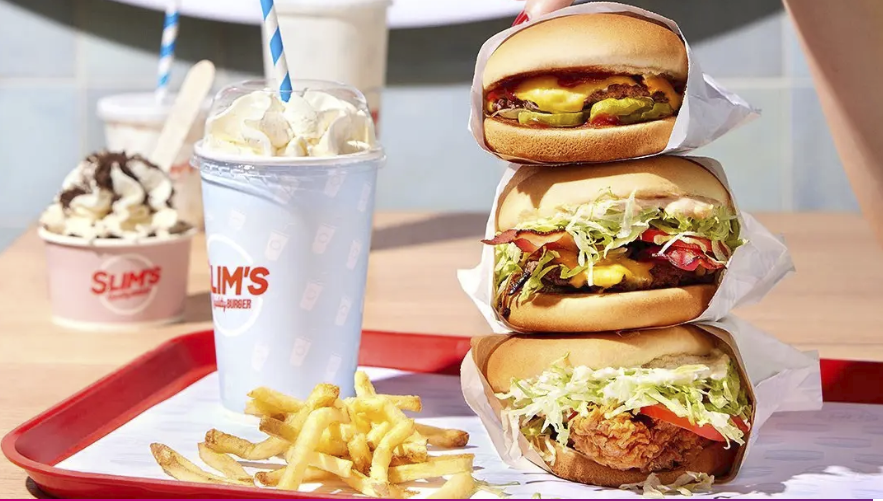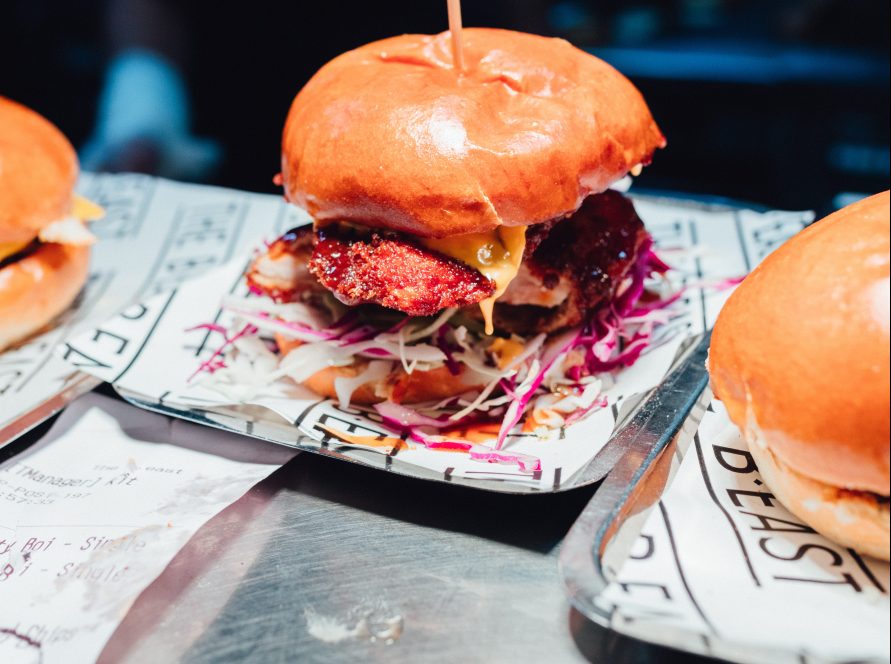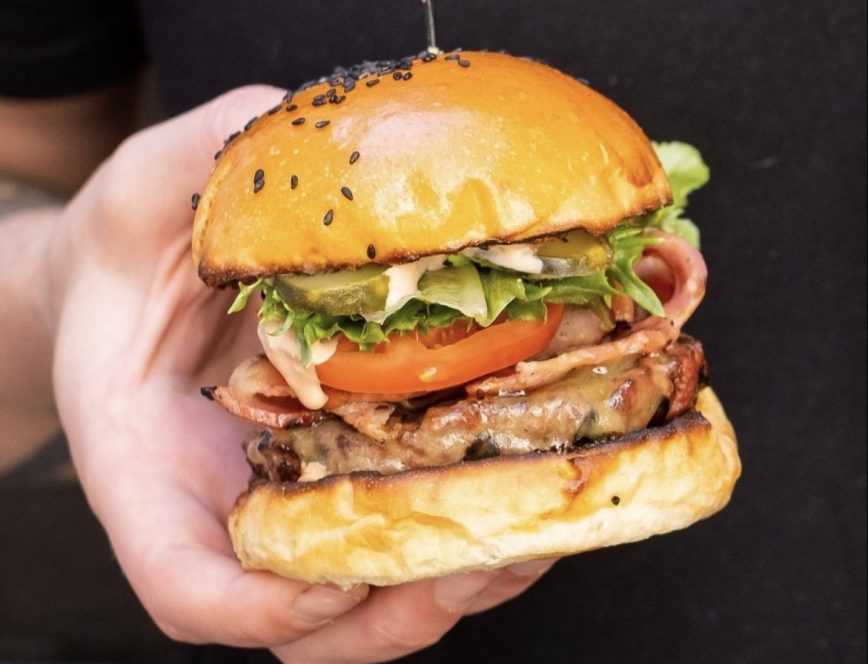Burgers are a loved, go-to meal for many of us. Whether it’s a fried chicken number with fresh slaw or a cheeseburger with mustard and pickles — everyone has a favourite. But with time, palates have evolved and consequently so has the burger landscape.
Hospitality speaks with Nik Rollison from Slim’s Quality Burger, Joel Stephens from Bread & Bone, and Jarrod Moore from The Beast about what goes into creating the modern burger offering. A less-is-more approach, honing in on the classics, and focusing on consistency and quality all play a part in what consumers are looking for today.
Slim’s Quality Burger is a Sydney-based brand that has become known for its quick, made-to-order burgers and has outlets in Westfield Sydney, Mount Druitt, and Marrickville. Director Nik Rollison says that while consumers are looking for choice when it comes to burgers, it doesn’t mean venues need to have a menu listing completely different products.
“Today’s consumer has a broader palate, so we have three main offerings of beef, chicken, and plant-based,” he says. “We have to cater to a broader spectrum of customers, but we want to remain focused on the core product at the end of the day.”
The menu does seem large at first glance, but as Rollison explains, it lists base burgers that come in various sizes with minor changes. “It’s actually the same product served in different ways,” says Rollison.
The menu features base burgers Slim’s Original and the Bacon Works, which come in the standard size with one patty, along with double and triple versions. There’s also a double deluxe cheeseburger; veggie; crispy chicken; crispy chicken club; grilled chicken club; and crispy chicken on the menu which have similar proteins but alternate fillings.
Slim’s Quality Burger focuses on freshness across its range, using local Queensland and Tasmanian potatoes for its chips which are delivered fresh along with 100-per-cent New South Wales Angus beef for its patties.
For Rollison and the team, the concept of a base menu came about after they noticed consumers were more interested in classic options rather than extravagant, experimental burger concepts.
“If you think back three years ago, a lot of burger operators were featuring behemoth burgers covered in all kinds of different sauces, dripping in cheeses, and with added fried chicken … almost like a Frankenstein burger if you will,” he says. “I think the general consensus is it’s not a lasting style, and people are circling back to the classics. Simple is best.”

Joel Stephens of Adelaide venue Bread & Bone has also noticed consumers are leaning into the classics. “Two out of 10 people from the crowds we get in will venture into different types of burgers,” he says. The venue’s B&B burger is one of the popular items at the eatery and features beef, smoked bacon, cheese, tomato, lettuce, caramelised onions, pickles, and pink sauce.
Along with the B&B burger, the cheeseburger, buttermilk fried chicken burger, and the 300 are the most ordered burgers. While Stephens admits classics sell well over the more unique items on the menu, he thinks a little creativity is a good thing.
“I think a small, unique twist is still pretty sought after these days, but it has to be done well — that’s a high priority,” he says. An example is the Wagyu and roasted bone marrow burger which sees a 200g Wagyu patty teamed with Comte cheese, black garlic mayo, pickled shallots, and porcini salt on a charcoal bun.
Consistency is vital for a burger venue, and Stephens has noticed consumers often revisit their favourites when they return to the store. “When people find something they like, they stick to it,” he says. “For some, it’s like, ‘I haven’t been to Bread & Bone in a while … I miss my B&B burger’.”
Quality stems from making the time to make patties and fillings in-house and taking additional steps such as hand-slicing buns. “Things such as having a decent sauce rather than just a standard ketchup, toasting your buns properly, and using caramelised onions rather than just putting onion on all adds up,” says Stephens. “If you’re not doing it, people notice in the end.”
It’s also about remaining flexible and providing options for patrons to customise burgers to their taste. “Pleasing your customer base is always a good start, and we always try to say yes to most things if we can make changes to make someone happy,” he says. “I would say every second docket says, ‘Add this and change that’. Everyone is particular about what they like.”

Executive Chef Jarrod Moore from The Beast in Melbourne is of the belief a burger menu should focus on quality rather than quantity. He says the approach comes from consumers knowing what they like and being increasingly aware of provenance when it comes to ingredients. “People are much more schooled in what makes a good or great burger these days,” says the chef. “Everyone in Melbourne is a foodie these days, so if you start cutting corners and swapping out ingredients for lower-quality mass produce, your customers will know.”
The Beast’s menu features 11 burgers including those made with Wagyu beef sourced from McGregor’s Artisan Butchery in Templestowe along with Southern fried chicken and chicken katsu fillet. There’s also plant-based sweet potato and lentil patties plus a mock Southern fried chicken take. The burgers are all filled with house ingredients, with the team making their own roast chicken gravy, sauces, and other seasonings in the kitchen. “We want to have something for everyone using flavours that are all our own,” says Moore.
Like Stephens, Moore also believes offering additional fillings for customisation is important to keep patrons happy. “Giving customers options and making sure anyone can come in and feel like they’ve been considered makes them keep coming back,” says Moore. “Lots of people come in and ask if we can throw some pineapple or an egg in their burger … and we’ll absolutely do it if we can.”

The Beast’s menu has a range of plant-based options, too. “We make sure the same love and attention goes into them as everything else.” It’s a move that’s paid off, with Moore noting a rise in popularity of plant-based burgers over the last few years, with the options now making up more than one-third of the venue’s sales.
For today’s burger venues, it all comes down to turning first-time visitors into return customers, something that can be tricky in a saturated market. “Having a good-quality product all the time is what brings people back,” says Stephens. “There’s so many other burger places to try if someone doesn’t like one … they don’t have to go too far.”
But standing out from the crowd can be done by setting the bar high in relation to purchasing premium ingredients and being open to making small changes that result in happy customers. “The quality of produce and a good amount of love is important,” says Moore. “If a venue has a big range but everything is just ok, people probably won’t be returning.”
Rollison agrees, and believes sticking to an achievable number of menu options relevant to a venue’s style is important. “I think a lot of restaurants these days have lost their way and they try to do too much,” he says. “In doing so, they put forward a wide variety of average products versus a focused selection of excellent products.”
Sponsored Content

Posiflex ZT Series: the game changer
Sponsored by Goodson

How Square Kiosk helps hospo boost productivity and improve customer experience
Sponsored by Square
Trending Now
Resources
Lorem ipsum dolor sit amet, consectetur adipiscing elit. Fusce ac ornare lectus. Sed bibendum lobortis...
Lorem ipsum dolor sit amet, consectetur adipiscing elit. Fusce ac ornare lectus. Sed bibendum lobortis...
Sign up for our newsletter
